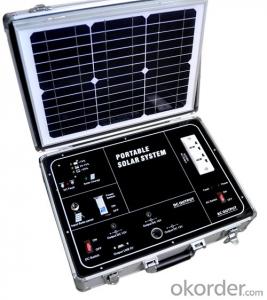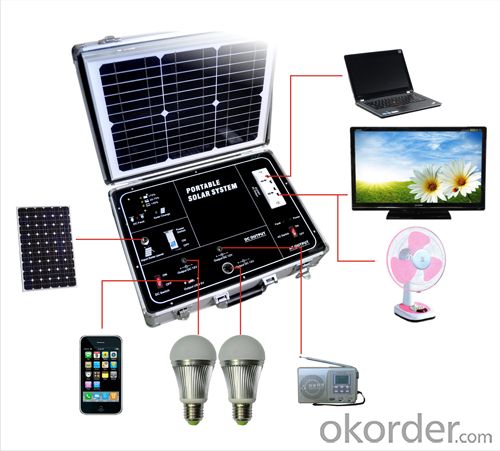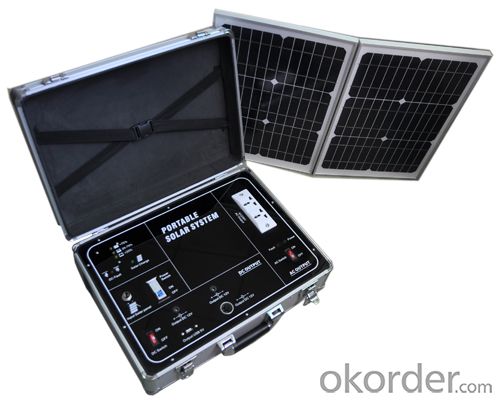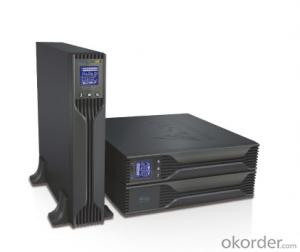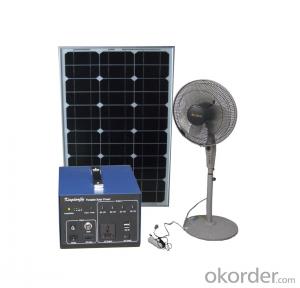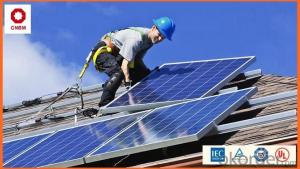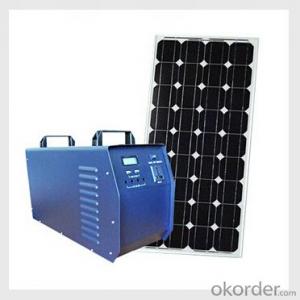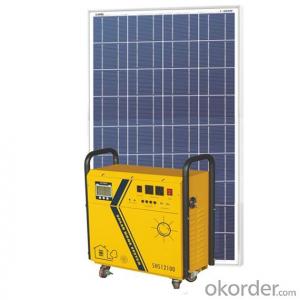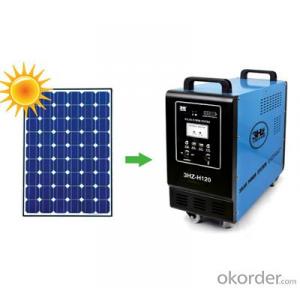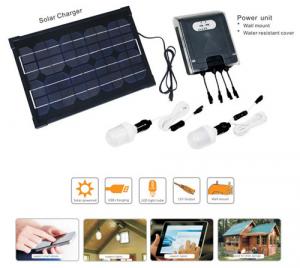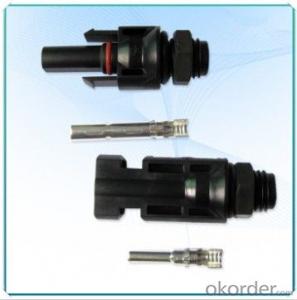Solec Solar Energy Systems Portable Solar Power System 500W Modified Sine Wave with 34W Solar Panels
- Loading Port:
- Shekou
- Payment Terms:
- TT OR LC
- Min Order Qty:
- 10 unit
- Supply Capability:
- 5000 unit/month
OKorder Service Pledge
OKorder Financial Service
You Might Also Like
Functions
1.The solar power system designed to provide DC power and AC power ,supply for lighting, mobile phone charging, run the
DC Fan and Radio, and TV ,computer etc.
2.Built-in PWM charge controller, real time display of battery capacity and load status.
3.Built-in maintenance-free Lead-acid battery.
4.With several output socket, can output voltage DC12V and USB DC5V at the same time.
5. Built-in DC to AC power inverter, can output AC220V/50HZ ,
6.Voice warning and together LED indicator shows the battery get low.
Technical parameters
| System voltage | 12V |
| Battery capacity | 20AH/12V |
| Max.charge current | 10A |
| Build-in solar panel Power | 38W, open circuit voltage:17.5V |
| Output voltage | DC output : DC socket: 12V/5A USB output: DC5V/800mA Cigar lighter: DC12V/10A Output AC : AC220V/50HZ |
| load power | DC Power: <120W (total power), AC Power:<500W |
| LVD (Low-voltage dis-cononect) | DC load LVD: 11.0V, AC load LVD: 10.0V |
| DC load re-connect voltage | 12.5V |
| HVD (High-voltage dis-connect) | 15.5V |
| Weight | 15KG |
| Dimension | 46*34*16 cm |
- Q: What are the different types of solar energy systems?
- There are primarily three types of solar energy systems: photovoltaic (PV) systems, solar thermal systems, and concentrated solar power (CSP) systems. PV systems use solar panels to convert sunlight directly into electricity, while solar thermal systems use sunlight to heat water or air for various purposes such as heating buildings or generating electricity. CSP systems, on the other hand, concentrate sunlight using mirrors or lenses to produce steam, which drives a turbine to generate electricity.
- Q: Can solar energy systems be installed on flat surfaces?
- Yes, solar energy systems can be installed on flat surfaces such as roofs or ground-mounted structures.
- Q: How do solar energy systems impact the environment?
- Solar energy systems have a positive impact on the environment as they produce clean and renewable energy. They do not emit greenhouse gases or contribute to air pollution, which helps improve air quality and reduce the effects of climate change. Additionally, solar panels require minimal water for maintenance compared to other forms of energy generation, conserving this precious resource. By reducing our reliance on fossil fuels, solar energy systems play a crucial role in mitigating environmental degradation and promoting a sustainable future.
- Q: Can solar energy systems be used in areas with limited access to solar surge protection devices?
- Yes, solar energy systems can be used in areas with limited access to solar surge protection devices. While surge protection devices are important for protecting solar panels and other system components from power surges and voltage spikes, there are alternative methods to mitigate the risks. These can include using high-quality solar inverters with built-in surge protection, implementing proper grounding techniques, and adhering to best practices in system design and installation. Although having access to surge protection devices is ideal, it is not a definitive requirement for the deployment of solar energy systems in areas with limited access to such equipment.
- Q: Can solar energy systems be used for emergency response operations?
- Yes, solar energy systems can be used for emergency response operations. Solar panels can generate electricity even during power outages, providing a reliable and sustainable source of energy to power critical equipment and facilities. Solar-powered generators can also be used to charge communication devices, run medical equipment, provide lighting, and support other emergency response activities in remote or disaster-stricken areas where access to traditional power sources may be limited or disrupted. Additionally, solar energy systems can help reduce dependence on fossil fuels and contribute to a more sustainable and resilient emergency response infrastructure.
- Q: Can solar energy systems be used in powering swimming pools or spas?
- Certainly, swimming pools or spas can be powered by solar energy systems. Solar pool heating systems harness the sun's energy to warm the water in the pool or spa, presenting a more sustainable and economical option compared to traditional heating methods. Typically, these systems comprise solar collectors, a pump, and a filter. The solar collectors, typically positioned on the roof or ground, absorb sunlight and transfer its warmth to the pool water. The pump circulates the water through the collectors and returns it to the pool, ensuring a continuous flow of heated water. By utilizing a renewable energy source, solar energy systems for swimming pools and spas not only lower energy expenses but also contribute positively to the environment.
- Q: Can solar energy systems be installed in urban areas?
- Yes, solar energy systems can be installed in urban areas. In fact, urban areas can be highly suitable for solar installations due to the availability of rooftops and open spaces on buildings. Additionally, advancements in solar technology have made it possible to integrate solar panels into urban infrastructure, such as solar-powered streetlights and parking meters. This allows urban areas to harness clean and renewable energy while utilizing available space efficiently.
- Q: Can solar energy systems be used in areas with high levels of air humidity?
- Yes, solar energy systems can be used in areas with high levels of air humidity. While high humidity can affect the efficiency of solar panels to some extent, it does not render them unusable. Solar panels can still generate electricity in such areas, although the output may be slightly lower compared to regions with lower humidity levels. Overall, solar energy systems remain a viable and effective option for power generation in humid environments.
- Q: How does the size of a solar energy system affect its performance?
- The size of a solar energy system directly affects its performance. A larger system will typically generate more electricity, as it has a greater capacity to capture sunlight and convert it into usable energy. This means that a larger system can meet a higher percentage of a household's energy needs, potentially even producing excess energy that can be fed back into the grid. On the other hand, a smaller system may not be able to generate enough electricity to fully satisfy the energy demands of a household, requiring additional supplementation from the grid. Therefore, the size of a solar energy system is a crucial factor in determining its overall performance and ability to provide sustainable energy.
- Q: How do solar energy systems affect the electrical wiring of a building?
- Solar energy systems can have an impact on the electrical wiring of a building. When solar panels are installed, they need to be connected to the existing electrical system. This typically involves adding a new electrical panel or inverter to convert the DC power from the solar panels to AC power that can be used in the building. Additionally, solar energy systems may require the installation of new wiring to connect the panels to the electrical panel. However, with proper installation and integration, solar energy systems should not negatively affect the electrical wiring of a building.
Send your message to us
Solec Solar Energy Systems Portable Solar Power System 500W Modified Sine Wave with 34W Solar Panels
- Loading Port:
- Shekou
- Payment Terms:
- TT OR LC
- Min Order Qty:
- 10 unit
- Supply Capability:
- 5000 unit/month
OKorder Service Pledge
OKorder Financial Service
Similar products
Hot products
Hot Searches
Related keywords
